HVACR Systems 122: Load Calculations
122-3: Heat Gain of a StructurePage 7
 |
| Click to enlarge |
Shown here is an example of Worksheet B partially completed for the example house for north facing glass only. It has been completed for the heating and cooling portions (cooling is highlighted in red). The fenestration glass door and windows/glass detailed on the form either face north or obviously are shaded by overhangs (assumed facing north) in this example. We will look at the particular tables necessary to obtain the particular values.
In the example shown, the structure has windows/glass (A-pg, C, and D), and a sliding glass door (E-gd) on the north side. From information about the windows, we find that they are double pane clear glass with wood, wood with metal clad or vinyl frame (1D-c) with a U-value of 0.57 (see below). The sliding glass door is single pane clear glass operable with metal no break (1A-c) giving us a U-value of 1.27, and the small A-pg plate glass windows are clear glass, single pane, fixed sash with metal no break (1B-c) giving us a U-value of 1.13 . This “table” is part of Table 2A of the MJ8AE Manual.
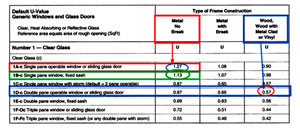 |
| Click to enlarge |
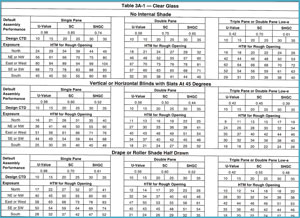 |
| Click to enlarge |
For the windows labeled as C and D, we assume Vertical or Horizontal Blinds with Slats at 45 Degrees. This is typical for most houses.
Looking at the “Double Pane” table (in the middle of Table 3A-1), we find that the U-value for the windows is 13 Btu/h per °F per square foot of this type of glass (under a Design CTD of 15 degrees), facing north (see below):
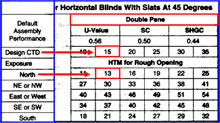 |
| Click to enlarge |
Notice that the U-value for this glass is .56 (very close to the default U-value of .57 in the table on the previous page).
This provides us with the heat gain Heat Transfer Multiplier for all the north facing double pane clear glass with wood, wood with metal clad or vinyl frame (1D-c).
For the sliding glass door (E-gd), we assume Drape or Roller Shade Half Drawn. This is typical for most houses.
 |
| Click to enlarge |
Looking at the “Single Pane” table (at the bottom/lower left of Table 3A-1), we find that the U-value for the sliding glass door is 22 Btu/h per °F per square foot of this type of glass (under a Design CTD of 15 degrees), facing north (see here):
For the small “plate” glass windows in the exterior door (A-pg), we assume No Internal Shade. This is typical for most houses.
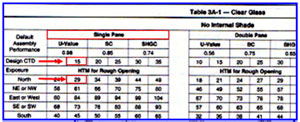 |
| Click to enlarge |
Looking at the “Single Pane” table (at the top/ left of Table 3A-1), we find that the U-value for the “plate” glass windows is 29 Btu/h per °F per square foot of this type of glass (under a Design CTD of 15 degrees), facing north (see insert here):
Remember, we have only looked at finding the HTMs for north-facing glass (or assumed north-facing glass). You would follow the same steps for glass facing east, west, or south utilizing the same tables assuming the glass was not completely shaded by overhang (typically assumed to be less than two feet of overhang). The process will be the same except that the entries on Worksheet B will be at the right top portion of the form under All Other Directions (east, west, and south).
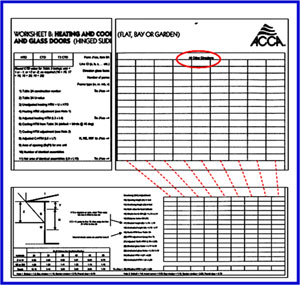 |
| Click to enlarge |
The remaining 9 columns on Worksheet B are for windows and/or glass doors that may be affected by an overhang. Each of these 9 columns has 26 calculation lines because the overhang adjustment is evaluated for this type of glass. Some of these calculation lines do not apply when the overhang is not effective or when the glass is completed shaded by the overhang.
For every window and/or glass door that is affected by an overhang, you use Table 3E-1 (also appears on Worksheet B as shown here) to determine the load area of shaded and unshaded glass. The heat transfer multiplier (HTM) for the unshaded area equals the heat transfer multiplier (HTM) for the direction the glass faces. Overhang adjustments apply when calculating the cooling load.
Let’s assume that the example house has two “B” windows facing south that are affected by an overhang. We must utilize the lower left portion of Worksheet B to calculate the load area of shaded and unshaded glass and the associated cooling Heat Transfer Multipliers (HTM) necessary to calculate heat gain through these windows on Form J1AE.
 |
| Click to enlarge |
For the windows labeled as “B” we assume Vertical or Horizontal Blinds with Slats at 45 Degrees. Again, this is typical for most houses.
Looking at the “Double Pane” table (in the middle of Table 3A-1), we find that the U-value for the windows is 21 Btu/h per °F per square foot of this type of glass (under a Design CTD of 15 degrees), facing south (see insert):
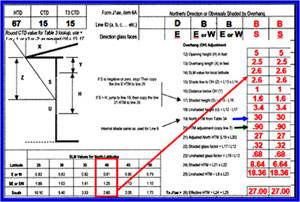 |
| Click to enlarge |
We then complete lines 1 through 26 (see insert below; only lines 12 through 26 are shown) to determine the effective Cooling Heat Transfer Multipliers for these windows. You would follow the same procedure for other windows with significant overhangs facing in other directions (except north).
Copyright © Blue C LLC. All rights reserved.